traction control MINI Hardtop 2 Door 2005 Owner's Manual
[x] Cancel search | Manufacturer: MINI, Model Year: 2005, Model line: Hardtop 2 Door, Model: MINI Hardtop 2 Door 2005Pages: 165, PDF Size: 2.32 MB
Page 5 of 165
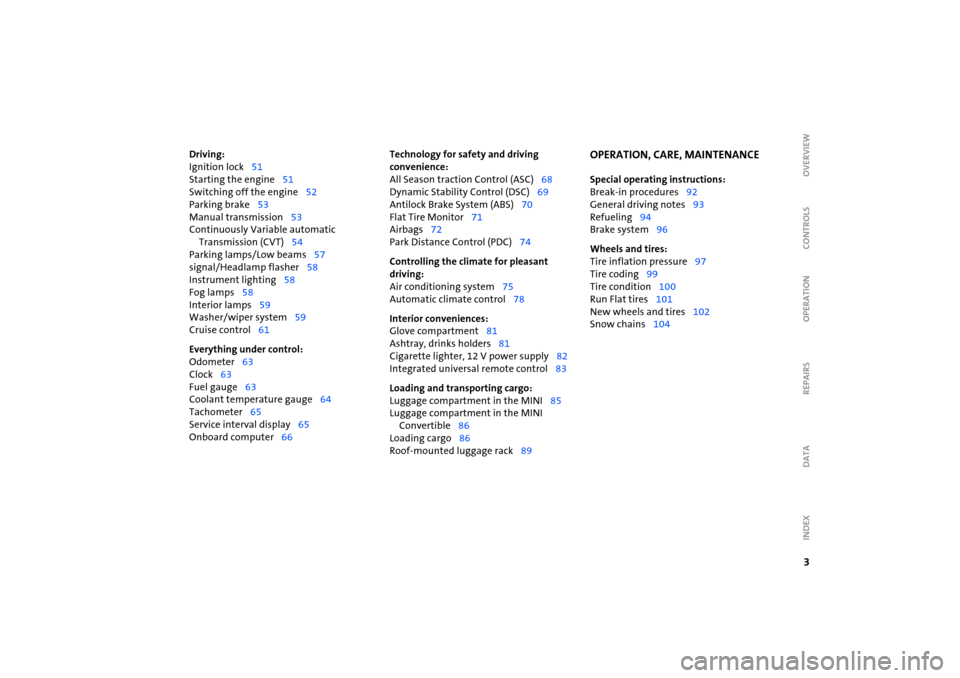
3OVERVIEW REPAIRS OPERATION CONTROLS DATA INDEX
Driving:Ignition lock
51
Starting the engine
51
Switching off the engine
52
Parking brake
53
Manual transmission
53
Continuously Variable automatic
Transmission (CVT)
54
Parking lamps/Low beams
57
signal/Headlamp flasher
58
Instrument lighting
58
Fog lamps
58
Interior lamps
59
Washer/wiper system
59
Cruise control
61
Everything under control:Odometer
63
Clock
63
Fuel gauge
63
Coolant temperature gauge
64
Tachometer
65
Service interval display
65
Onboard computer
66
Technology for safety and driving
convenience:All Season traction Control (ASC)
68
Dynamic Stability Control (DSC)
69
Antilock Brake System (ABS)
70
Flat Tire Monitor
71
Airbags
72
Park Distance Control (PDC)
74
Controlling the climate for pleasant
driving:Air conditioning system
75
Automatic climate control
78
Interior conveniences:Glove compartment
81
Ashtray, drinks holders
81
Cigarette lighter, 12 V power supply
82
Integrated universal remote control
83
Loading and transporting cargo:Luggage compartment in the MINI
85
Luggage compartment in the MINI Convertible
86
Loading cargo
86
Roof-mounted luggage rack
89
OPERATION, CARE, MAINTENANCESpecial operating instructions:Break-in procedures
92
General driving notes
93
Refueling
94
Brake system
96
Wheels and tires:Tire inflation pressure
97
Tire coding
99
Tire condition
100
Run Flat tires
101
New wheels and tires
102
Snow chains
104
Page 20 of 165
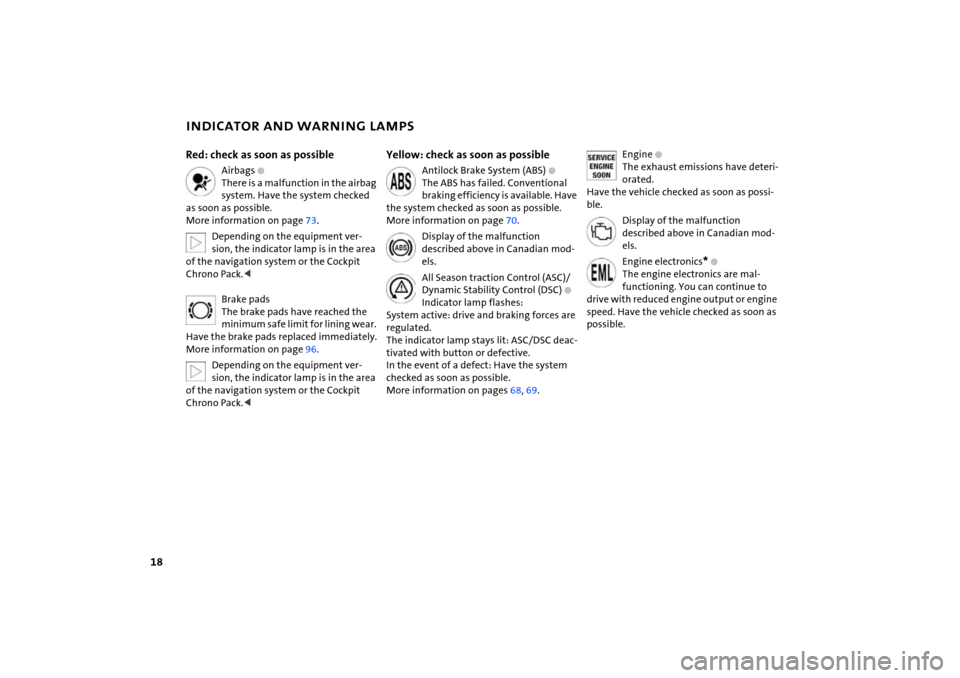
18
INDICATOR AND WARNING LAMPSRed: check as soon as possible
Airbags
+
There is a malfunction in the airbag
system. Have the system checked
as soon as possible.
More information on page
73.
Depending on the equipment ver
-
sion, the indicator lamp is in the area
of the navigation system or the Cockpit
Chrono Pack.
The brake pads have reached the
minimum safe limit for lining wear.
Have the brake pads replaced immediately.
More information on page
96.
Depending on the equipment ver
-
sion, the indicator lamp is in the area
of the navigation system or the Cockpit
Chrono Pack.<
Yellow: check as soon as possible
Antilock Brake System (ABS)
+
The ABS has failed. Conventional
braking efficiency is available. Have
the system checked as soon as possible.
More information on page
70.
Display of the malfunction described above in Canadian mod
-
els.All Season traction Control (ASC)/Dynamic Stability Control (DSC)
+
Indicator lamp flashes:
System active: drive and braking forces are
regulated.
The indicator lamp stays lit: ASC/DSC deac
-
tivated with button or defective.
In the event of a defect: Have the system
checked as soon as possible.
More information on pages
68, 69
.
Engine
+
The exhaust emissions have deteri
-
orated.
Have the vehicle checked as soon as possi
-
ble.
Display of the malfunction described above in Canadian mod
-
els.Engine electronics
* +
The engine electronics are mal
-
functioning. You can continue to
drive with reduced engine output or engine
speed. Have the vehicle checked as soon as
possible.
Page 51 of 165
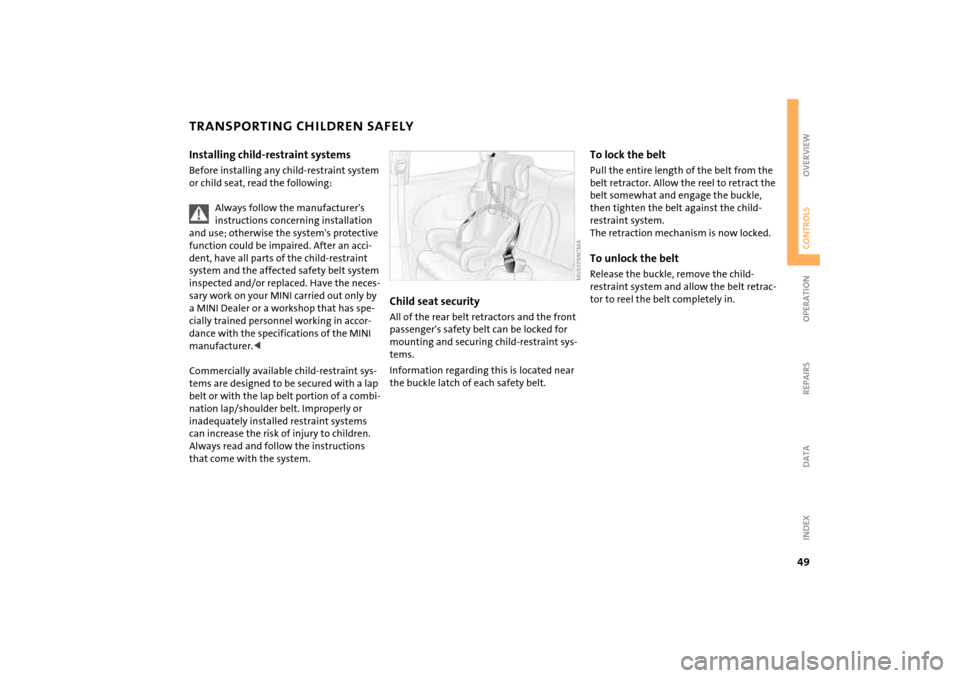
49
OVERVIEW REPAIRS OPERATIONCONTROLS DATA INDEX
TRANSPORTING CHILDREN SAFELYInstalling child-restraint systemsBefore installing any child-restraint system
or child seat, read the following:
Always follow the manufacturer's instructions concerning installation
and use; otherwise the system's protective
function could be impaired. After an acci
-
dent, have all parts of the child-restraint
system and the affected safety belt system
inspected and/or replaced. Have the neces
-
sary work on your MINI carried out only by
a MINI Dealer or a workshop that has spe
-
cially trained personnel working in accor
-
dance with the specifications of the MINI
manufacturer.
tems are designed to be secured with a lap
belt or with the lap belt portion of a combi
-
nation lap/shoulder belt. Improperly or
inadequately installed restraint systems
can increase the risk of injury to children.
Always read and follow the instructions
that come with the system.
Child seat securityAll of the rear belt retractors and the front
passenger's safety belt can be locked for
mounting and securing child-restraint sys
-
tems.Information regarding this is located near
the buckle latch of each safety belt.
To lock the beltPull the entire length of the belt from the
belt retractor. Allow the reel to retract the
belt somewhat and engage the buckle,
then tighten the belt against the child-
restraint system.
The retraction mechanism is now locked. To unlock the beltRelease the buckle, remove the child-
restraint system and allow the belt retrac
-
tor to reel the belt completely in.
Page 55 of 165
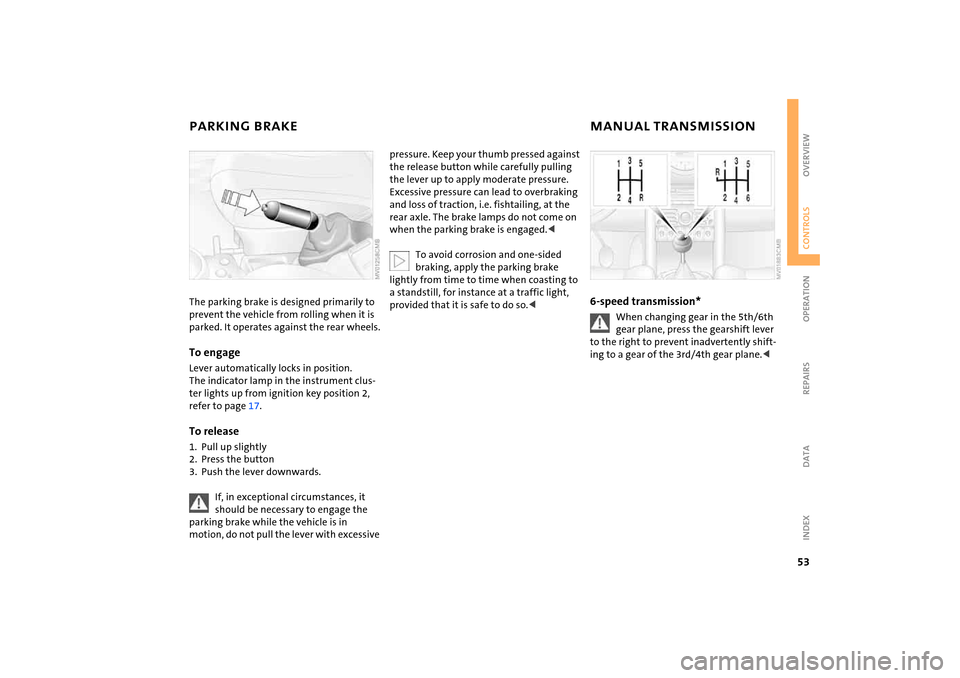
53
OVERVIEW REPAIRS OPERATIONCONTROLS DATA INDEX
PARKING BRAKE
MANUAL TRANSMISSION
The parking brake is designed primarily to prevent the vehicle from rolling when it is
parked. It operates against the rear wheels.To engageLever automatically locks in position.
The indicator lamp in the instrument clus
-
ter lights up from ignition key position
2,
refer to page
17.
To release1. Pull up slightly2. Press the button3. Push the lever downwards.
If, in exceptional circumstances, it should be necessary to engage the
parking brake while the vehicle is in
motion, do not pull the lever with excessive
pressure. Keep your thumb pressed against
the release button while carefully pulling
the lever up to apply moderate pressure.
Excessive pressure can lead to overbraking
and loss of traction, i.e. fishtailing, at the
rear axle. The brake lamps do not come on
when the parking brake is engaged.<
To avoid corrosion and one-sided braking, apply the parking brake
lightly from time to time when coasting to
a standstill, for instance at a traffic light,
provided that it is safe to do so.<
6-speed transmission*
When changing gear in the 5th/6th gear plane, press the gearshift lever
to the right to prevent inadvertently shift
-
ing to a gear of the
3rd/4th gear plane.<
Page 70 of 165
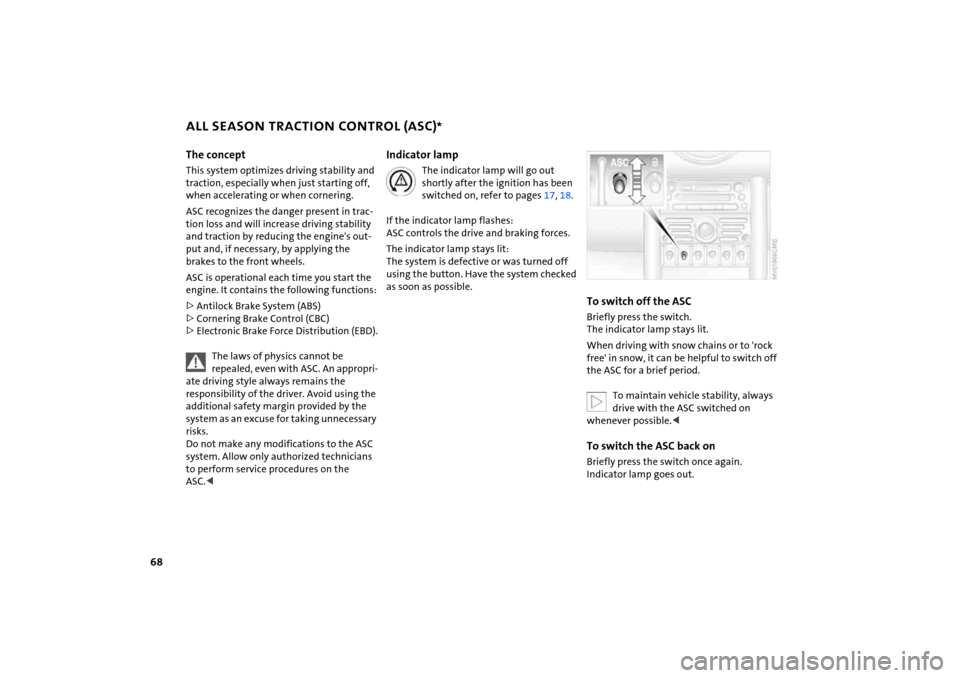
68
ALL SEASON TRACTION CONTROL (ASC)
*
The conceptThis system optimizes driving stability and
traction, especially when just starting off,
when accelerating or when cornering. ASC recognizes the danger present in trac
-
tion loss and will increase driving stability
and traction by reducing the engine's out
-
put and, if necessary, by applying the
brakes to the front wheels. ASC is operational each time you start the
engine. It contains the following functions:>Antilock Brake System (ABS)>Cornering Brake Control (CBC)>Electronic Brake Force Distribution (EBD).
The laws of physics cannot be repealed, even with ASC. An appropri
-
ate driving style always remains the
responsibility of the driver. Avoid using the
additional safety margin provided by the
system as an excuse for taking unnecessary
risks.
Do not make any modifications to the ASC
system. Allow only authorized technicians
to perform service procedures on the
ASC.<
Indicator lamp
The indicator lamp will go out shortly after the ignition has been
switched on, refer to pages
17, 18
.
If the indicator lamp flashes:
ASC controls the drive and braking forces.The indicator lamp stays lit:
The system is defective or was turned off
using the button. Have the system checked
as soon as possible.
To switch off the ASCBriefly press the switch.
The indicator lamp stays lit.When driving with snow chains or to 'rock
free' in snow, it can be helpful to switch off
the ASC for a brief period.
To maintain vehicle stability, always drive with the ASC switched on
whenever possible.<
To switch the ASC back onBriefly press the switch once again.
Indicator lamp goes out.
Page 71 of 165
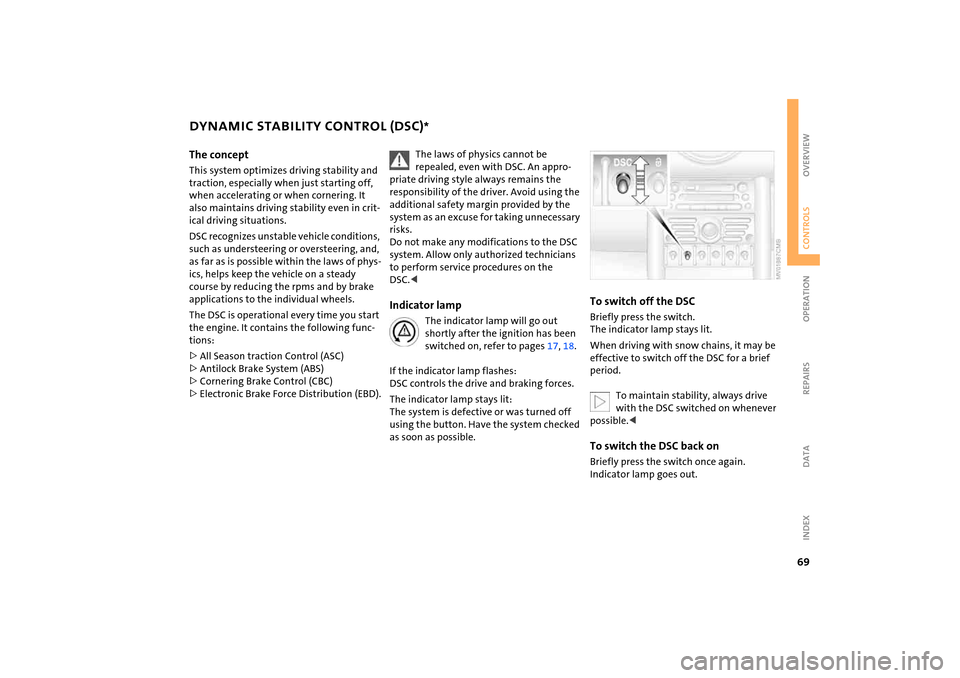
69
OVERVIEW REPAIRS OPERATIONCONTROLS DATA INDEX
DYNAMIC STABILITY CONTROL (DSC)
*
The conceptThis system optimizes driving stability and
traction, especially when just starting off,
when accelerating or when cornering. It
also maintains driving stability even in crit
-
ical driving situations.DSC recognizes unstable vehicle conditions,
such as understeering or oversteering, and,
as far as is possible within the laws of phys
-
ics, helps keep the vehicle on a steady
course by reducing the rpms and by brake
applications to the individual wheels.The DSC is operational every time you start
the engine. It contains the following func
-
tions:>All Season traction Control (ASC)>Antilock Brake System (ABS)>Cornering Brake Control (CBC)>Electronic Brake Force Distribution (EBD).
The laws of physics cannot be repealed, even with DSC. An appro
-
priate driving style always remains the
responsibility of the driver. Avoid using the
additional safety margin provided by the
system as an excuse for taking unnecessary
risks.
Do not make any modifications to the DSC
system. Allow only authorized technicians
to perform service procedures on the
DSC.
switched on, refer to pages
17, 18
.
If the indicator lamp flashes:
DSC controls the drive and braking forces. The indicator lamp stays lit:
The system is defective or was turned off
using the button. Have the system checked
as soon as possible.
To switch off the DSCBriefly press the switch.
The indicator lamp stays lit.When driving with snow chains, it may be
effective to switch off the DSC for a brief
period.
To maintain stability, always drive with the DSC switched on whenever
possible.<
To switch the DSC back onBriefly press the switch once again.
Indicator lamp goes out.
Page 101 of 165
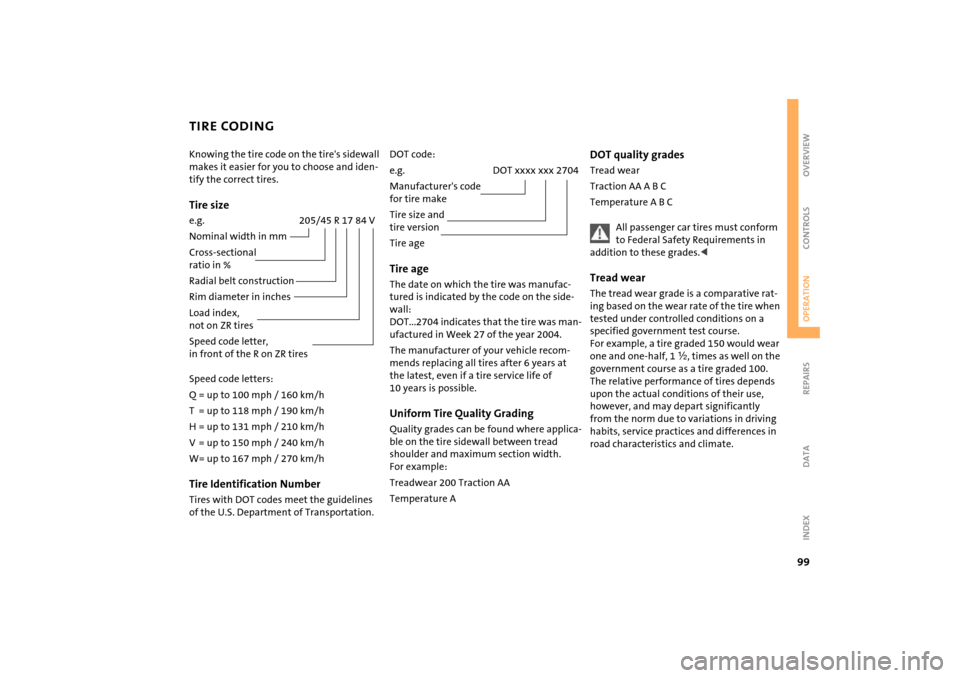
99
OVERVIEW REPAIRSOPERATIONCONTROLS DATA INDEX
TIRE CODINGKnowing the tire code on the tire's sidewall
makes it easier for you to choose and iden
-
tify the correct tires.Tire sizee.g. 205/45
R 17 84 V
Nominal width in mm Cross-sectional
ratio in % Radial belt construction Rim diameter in inches Load index,
not on ZR tiresSpeed code letter,
in front of the R on ZR tiresSpeed code letters:Q = up to 100 mph / 160
km/h
T= up to 118
mph
/ 190
km/h
H= up to 131
mph
/ 210
km/h
V= up to 150
mph
/ 240
km/h
W= up to 167
mph
/ 270
km/h
Tire Identification NumberTires with DOT codes meet the guidelines
of the U.S. Department of Transportation.
DOT code:e.g. DOT xxxx xxx 2704Manufacturer's code
for tire make Tire size and
tire version Tire age Tire ageThe date on which the tire was manufac
-
tured is indicated by the code on the side
-
wall:
DOT...2704 indicates that the tire was man
-
ufactured in Week 27 of the year 2004.The manufacturer of your vehicle recom
-
mends replacing all tires after 6
years at
the latest, even if a tire service life of
10
years is possible.
Uniform Tire Quality GradingQuality grades can be found where applica
-
ble on the tire sidewall between tread
shoulder and maximum section width.
For example:Treadwear 200 Traction AATemperature A
DOT quality gradesTread wear Traction AA A B C Temperature A B C
All passenger car tires must conform to Federal Safety Requirements in
addition to these grades.<
Tread wearThe tread wear grade is a comparative rat
-
ing based on the wear rate of the tire when
tested under controlled conditions on a
specified government test course.
For example, a tire graded 150 would wear
one and one-half, 1
γ, times as well on the
government course as a tire graded 100.
The relative performance of tires depends
upon the actual conditions of their use,
however, and may depart significantly
from the norm due to variations in driving
habits, service practices and differences in
road characteristics and climate.
Page 102 of 165
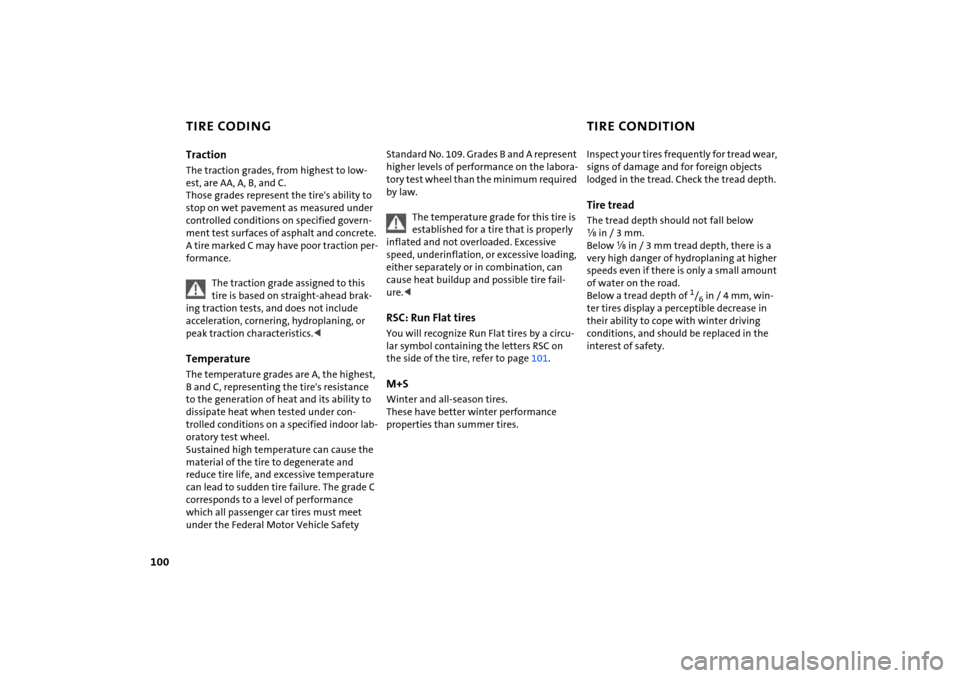
100
TIRE CODING
TIRE CONDITION
Traction The traction grades, from highest to low
-
est, are AA, A, B, and C.
Those grades represent the tire's ability to
stop on wet pavement as measured under
controlled conditions on specified govern
-
ment test surfaces of asphalt and concrete.
A tire marked C may have poor traction per
-
formance.
The traction grade assigned to this tire is based on straight-ahead brak
-
ing traction tests, and does not include
acceleration, cornering, hydroplaning, or
peak traction characteristics.
to the generation of heat and its ability to
dissipate heat when tested under con
-
trolled conditions on a specified indoor lab
-
oratory test wheel.
Sustained high temperature can cause the
material of the tire to degenerate and
reduce tire life, and excessive temperature
can lead to sudden tire failure. The grade C
corresponds to a level of performance
which all passenger car tires must meet
under the Federal Motor Vehicle Safety
Standard No. 109. Grades B and A represent
higher levels of performance on the labora
-
tory test wheel than the minimum required
by law.
The temperature grade for this tire is established for a tire that is properly
inflated and not overloaded. Excessive
speed, underinflation, or excessive loading,
either separately or in combination, can
cause heat buildup and possible tire fail
-
ure.
lar symbol containing the letters RSC on
the side of the tire, refer to page
101
.
M+SWinter and all-season tires.
These have better winter performance
properties than summer tires.
Inspect your tires frequently for tread wear,
signs of damage and for foreign objects
lodged in the tread. Check the tread depth.Tire tread The tread depth should not fall below
ε in / 3 mm.
Below ε
in / 3 mm tread depth, there is a
very high danger of hydroplaning at higher
speeds even if there is only a small amount
of water on the road.
Below a tread depth of
1/6 in / 4 mm, win
-
ter tires display a perceptible decrease in
their ability to cope with winter driving
conditions, and should be replaced in the
interest of safety.
Page 105 of 165
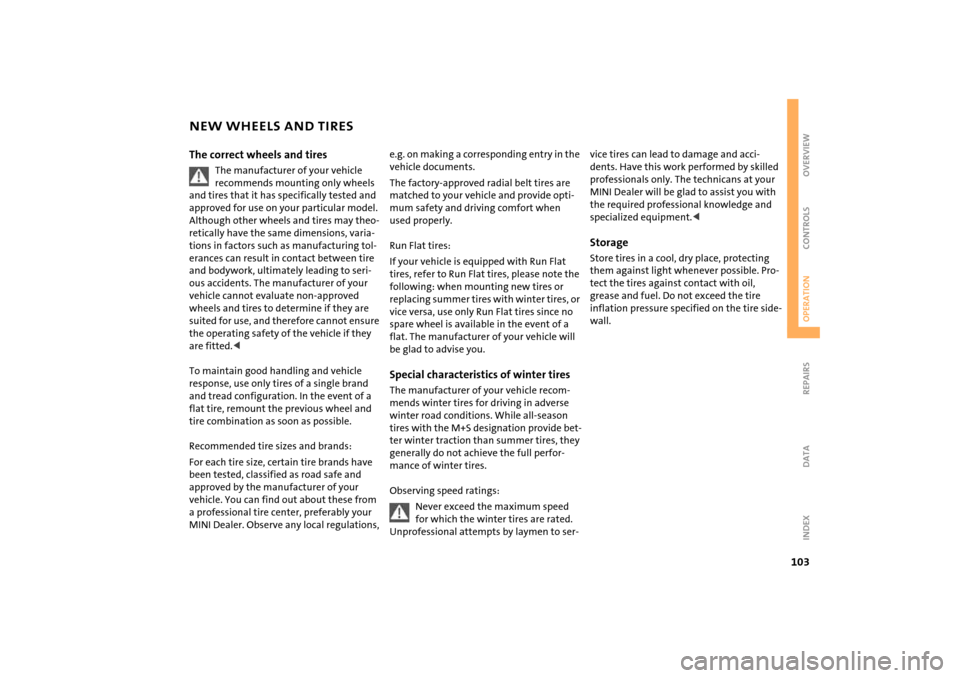
103
OVERVIEW REPAIRSOPERATIONCONTROLS DATA INDEX
NEW WHEELS AND TIRESThe correct wheels and tires
The manufacturer of your vehicle
recommends mounting only wheels
and tires that it has specifically tested and
approved for use on your particular model.
Although other wheels and tires may theo
-
retically have the same dimensions, varia
-
tions in factors such as manufacturing tol
-
erances can result in contact between tire
and bodywork, ultimately leading to seri
-
ous accidents. The manufacturer of your
vehicle cannot evaluate non-approved
wheels and tires to determine if they are
suited for use, and therefore cannot ensure
the operating safety of the vehicle if they
are fitted.
and tread configuration. In the event of a
flat tire, remount the previous wheel and
tire combination as soon as possible.Recommended tire sizes and brands:For each tire size, certain tire brands have
been tested, classified as road safe and
approved by the manufacturer of your
vehicle. You can find out about these from
a professional tire center, preferably your
MINI Dealer. Observe any local regulations,
e.g. on making a corresponding entry in the
vehicle documents. The factory-approved radial belt tires are
matched to your vehicle and provide opti
-
mum safety and driving comfort when
used properly.Run Flat tires:If your vehicle is equipped with Run Flat
tires, refer to Run Flat tires, please note the
following: when mounting new tires or
replacing summer tires with winter tires, or
vice versa, use only Run Flat tires since no
spare wheel is available in the event of a
flat. The manufacturer of your vehicle will
be glad to advise you.Special characteristics of winter tires The manufacturer of your vehicle recom
-
mends winter tires for driving in adverse
winter road conditions. While all-season
tires with the M+S designation provide bet
-
ter winter traction than summer tires, they
generally do not achieve the full perfor
-
mance of winter tires. Observing speed ratings:
Never exceed the maximum speed for which the winter tires are rated.
Unprofessional attempts by laymen to ser
-
vice tires can lead to damage and acci
-
dents. Have this work performed by skilled
professionals only. The technicans at your
MINI Dealer will be glad to assist you with
the required professional knowledge and
specialized equipment.
-
tect the tires against contact with oil,
grease and fuel. Do not exceed the tire
inflation pressure specified on the tire side
-
wall.
Page 150 of 165
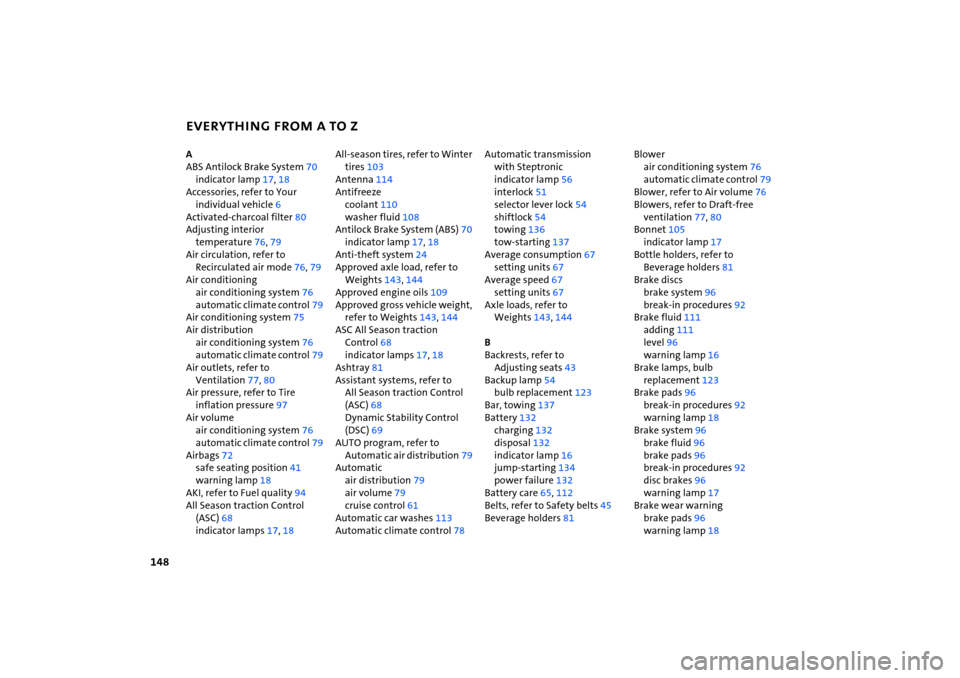
EVERYTHING FROM A TO Z
148
A ABS Antilock Brake System
70
indicator lamp
17, 18
Accessories, refer to Your
individual vehicle
6
Activated-charcoal filter
80
Adjusting interior
temperature
76, 79
Air circulation, refer to
Recirculated air mode
76, 79
Air conditioning
air conditioning system
76
automatic climate control
79
Air conditioning system
75
Air distribution
air conditioning system
76
automatic climate control
79
Air outlets, refer to
Ventilation
77, 80
Air pressure, refer to Tire
inflation pressure
97
Air volume
air conditioning system
76
automatic climate control
79
Airbags
72
safe seating position
41
warning lamp
18
AKI, refer to Fuel quality
94
All Season traction Control
(ASC)
68
indicator lamps
17, 18
All-season tires, refer to Winter
tires
103
Antenna
114
Antifreeze
coolant
110
washer fluid
108
Antilock Brake System (ABS)
70
indicator lamp
17, 18
Anti-theft system
24
Approved axle load, refer to
Weights
143
, 144
Approved engine oils
109
Approved gross vehicle weight,
refer to Weights
143
, 144
ASC All Season traction
Control
68
indicator lamps
17, 18
Ashtray
81
Assistant systems, refer to
All Season traction Control
(ASC)
68
Dynamic Stability Control
(DSC)
69
AUTO program, refer to
Automatic air distribution
79
Automatic
air distribution
79
air volume
79
cruise control
61
Automatic car washes
113
Automatic climate control
78
Automatic transmission
with Steptronic
indicator lamp
56
interlock
51
selector lever lock
54
shiftlock
54
towing
136
tow-starting
137
Average consumption
67
setting units
67
Average speed
67
setting units
67
Axle loads, refer to
Weights
143
, 144
B Backrests, refer to
Adjusting seats
43
Backup lamp
54
bulb replacement
123
Bar, towing
137
Battery
132
charging
132
disposal
132
indicator lamp
16
jump-starting
134
power failure
132
Battery care
65, 112
Belts, refer to Safety belts
45
Beverage holders
81
Blower
air conditioning system
76
automatic climate control
79
Blower, refer to Air volume
76
Blowers, refer to Draft-free
ventilation
77, 80
Bonnet
105
indicator lamp
17
Bottle holders, refer to
Beverage holders
81
Brake discs
brake system
96
break-in procedures
92
Brake fluid
111
adding
111
level
96
warning lamp
16
Brake lamps, bulb
replacement
123
Brake pads
96
break-in procedures
92
warning lamp
18
Brake system
96
brake fluid
96
brake pads
96
break-in procedures
92
disc brakes
96
warning lamp
17
Brake wear warning
brake pads
96
warning lamp
18